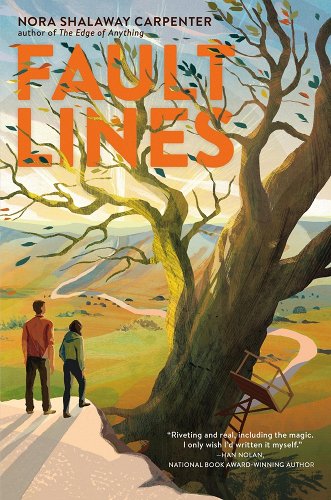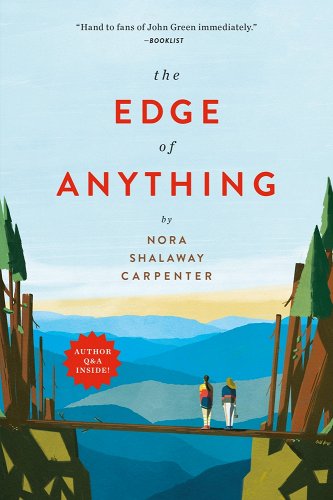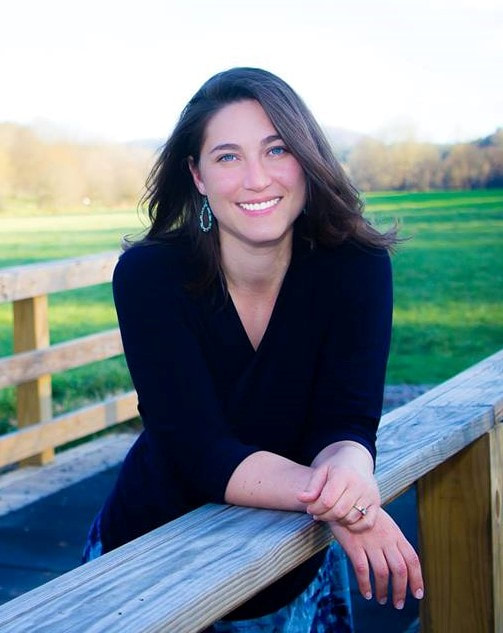Interview by Anne-Marie Strohman
Nora is the kind of writing mentor you want to have sitting on your shoulder during every writing session. She’s kind and encouraging, and she knows her stuff. I had heard of Nora and the first short story collection she’d edited, Rural Voices, before I encountered her in person. A champion for underheard voices AND someone who loves short stories? I sensed in Nora a kindred spirit. I’ve heard her speak on short stories, and I’ve attended her Highlights Mini-Course on Short Fiction. I was thrilled that she agreed to speak with me about her new novel, Fault Lines. Nora’s kindness and wisdom show through in each answer of this interview. I hope you’ll enjoy Nora and her work as much as I do. —Anne-Marie
KidLit Craft: You shared in Sarah Aronson’s newsletter that you had to get over some fears to give yourself permission to start writing Fault Lines. Was the story idea one you’d had for a while?

Nora Shalaway Carpenter: Yes, the fears were mainly about writing a story with a super controversial issue at its core, one that is particularly controversial in rural West Virginia, where I grew up and where the book is set. I’d known for a while that I wanted to write a story that involved fracking, due to its tremendous impact on me and my childhood homeplace, but it took me a long time to figure out how to do so in an organic way that all readers, regardless of what side of the resource extraction debate they currently fall on, could relate to. I didn’t want to write just about fracking. I wanted to show how the industry impacts all the people who live and work amongst it; how realities that I honestly wish were more black and white (so there could be obvious solutions) simply aren’t; and how connections with people and the earth itself can change even the deepest rooted beliefs, or at least make them more nuanced.
So I had my setting from the get go. The trick was finding characters that were both flawed and complex, but also relatable. Viv came fairly easily. I’d been wanting to write an angry, “aggressive” female character for a while because I identify very much with that kind of person, who speaks her mind and knows what she wants, but doesn’t always fit in so well in rural Appalachia (or many parts of the US, actually). And since I was already exploring some gender stereotypes, it made sense to make Dex not “traditionally masculine.” The plot came pretty naturally from a deep dive into the question I posed myself with these two characters: “what if an anti-fracking teen (Viv) and a teen who relied on the fracking industry to avoid poverty (Dex) found themselves drawn to each other, and even falling in love?”
KLC: Plotter, pantser, or plantser? How do you approach a novel?
Nora: When I first started writing, I was a full on pantser. I had no idea what I was doing, really, and I think this approach works especially well for people who are newer to writing, as I was, or who have a really long time to work on a story. (laughs) It feels less confined. But when I sold on proposal, pantsing was simply no longer an option. I had a deadline that I needed to meet, plus I had to provide a synopsis in order to even sell the book. The horror!
But I learned that taking a few weeks to figure out the basic plot points of a story–my synopses average about four to five pages–made the process of writing SO MUCH EASIER. Not that writing is ever easy. But it was easiER. Instead of having to stare into the blank space of the story every day, I simply looked at my synopsis and knew exactly what I needed to write that day.
Now, I want to be clear that I am not one of those people who outlines every scene and chapter. That is way too structured for me and I can almost feel my creative brain shutting down just thinking about it. Instead, I write a basic, loose outline that allows for plenty of creative freedom. Things do change as I work, and when that happens, I go back and adjust the synopsis as needed. But the major points rarely change. Before I start writing in earnest, I know the character arcs, the worst moment, the turn / middle / something happens from which there is no going back for the protagonist(s), and the climactic scene.
KLC: The story you tell is grounded in a contemporary real world, but it has one or two “magical” elements–really unexplained phenomenon that Viv explains in a certain way. Dex also sees a rare white deer at a few points in the novel, which is symbolic and feels a bit magical to him as well. How did these elements show up for you as you were writing? What made you decide to put them in/keep them?

Nora: As soon as I started writing, the magical elements showed up. In fact, I tried really hard NOT to include them; my first novel The Edge of Anything is strictly contemporary, and I was concerned my editor wouldn’t be into the magical elements. But when I removed the magic, the story felt stiff and lifeless to me. So that was another time I needed to put on my brave girl wings and write what felt right and natural to me, even though I was worried my agent and editor (and readers) might think it was weird. Trying to write the story as completely realistic contemporary ended up being a good exercise in that it showed me I definitely needed the magic there; I wasn’t interested in the story otherwise. Looking back, it makes sense to me. I have always felt a deep, almost spiritual/magical connection with the natural world. I think a lot of people who spend time in nature feel it. That’s what was coming through in my writing.
KLC: I’m curious about Oscar, who befriends Dex, and Tolly, one of Oscar’s oldest friends who has some history with Viv. Oscar is such a good guy, and Tolly is such a tool. But there are complexities around both characters, especially their relationship, as Oscar has to confront the fact that he doesn’t approve of or support Tolly’s behavior. Their presence adds complexity to the story, and also gives us a little microcosm of why someone might not respond to something that’s unjust, and what it takes to take a stand. When did these two show up in your writing process? What work did you do to make sure they earned their keep in the story?
Nora: Oscar showed up immediately as Dex’s key friend, but I did a lot of revision work to figure out who he really was and what he wanted. Tolly is actually an amalgamation of two initial characters, one of whom I realized simply didn’t earn his place in the book.
Tolly and Oscar represent two sides of traditional masculinity that show up in probably every community, but definitely the one in which I grew up in rural West Virginia. On the one hand, there’s the kid who just exudes toxic masculinity and self assuredness. As a reader, it might be tempting to wonder why Viv could ever fall for someone like that, but such people tend to also have magnetic personalities and be super charming until they’re not. Also, Tolly wasn’t always such a tool. People constantly change, and not always for the better.
Oscar, on the other hand, is also traditionally masculine, but he’s a genuinely nice person. After revisions, Oscar ended up as one of my favorite characters. Sure, he has some bro culture qualities, but I love that readers can watch him grow throughout the story. They can see him start to shed this role he’s playing, and so start to leave Tolly behind, which is an experience many of us have had to do with former friends who didn’t grow in positive ways. It’s sad, but it’s part of life, too.
I also very intentionally had Dex misjudge Oscar at first. Dex is so used to being misjudged, but he goes and does the same thing to someone else. That’s an important concept that I hope readers notice and reflect upon.
KLC: What advice do you have for writers tackling a Dual POV novel? (I’m asking this selfishly! I have one in the works.)
Nora: Ha! So you already know you’re doing twice as much work by having two protagonists. I love multiple POV books, so I guess it’s not really surprising that both of my novels have been dual POV. My biggest piece of advice is that you take enough planning time to figure out how to get the emotional arcs and external goal arcs of both protagonists to peak simultaneously. This isn’t a *rule*, of course, and there are probably books out there that do it differently. But for me, this is what makes dual POV books especially satisfying. It will probably be a bit like figuring out a jigsaw puzzle until you get the timing right, but once you do, the reader’s satisfaction will be worth all the effort!
KLC: How has the KidLit community been important to your writing career?
Nora: It’s difficult to overstate how crucial community has been for me. Writing isn’t done in a vacuum. Learning isn’t done in a vacuum. And opportunities certainly aren’t found in a vacuum. So many of my career opportunities–from finding an agent to breaking into the teaching scene–have been made much smoother because I had guidance from more experienced writers. Because of this, I do try to mentor as much as I can and uplift / open doors for others when it’s in my ability to do so. A big part of finding this community happened during my MFA program, but I also actively seek out other writers at conferences and events. It is rare for me to leave a writing event without a new friend!
KLC: What can Nora Shalaway Carpenter fans look forward to next?
Nora: Hopefully many more books, but the only one I can sort of talk about right now is a new anthology. I can’t share all the details, but it’s coming in spring 2025 and is full of beloved MG and YA authors, as well as some up-and-coming stars. In terms of teaching, Rob Costello and I are offering our Highlight’s Foundation virtual mini course on short fiction in January 2024. It’s a steal at just $59. You can sign up here: Intro to Writing Short Fiction: A Two-Night Mini for MG & YA Authors – Highlights Foundation. I’ll also be on faculty at next year’s Whole Novel Workshop again. The November workshop is already sold out, so look for sign ups for next year’s Workshop in the new year. If you have finished a novel, I cannot stress how incredible this in person workshop is, not only for help with craft, but finding / building a writing community, too. I describe the experience as essentially a shortened MFA residency, and you’ll leave with a wonderful cohort, new ideas, and so many advocates of your work.

A native of rural West Virginia, Nora Shalaway Carpenter lives and writes in the mountains of North Carolina. Her young adult novels and anthologies have been named “Best of the Year” by NPR, Kirkus Reviews, Bank Street Books, and A Mighty Girl, and have won accolades including the Junior Library Guild Gold Standard Selection, the Whippoorwill Award for authentic rural fiction, and the Nautilus Award championing “better books for a better world.” Nora holds an MFA from Vermont College of Fine Arts and serves as faculty for the Highlights Foundation’s Whole Novel Workshop and Intro to Short Fiction class.
Find Nora on social media:
For more on using contrast in your writing:
Anne-Marie Strohman (co-editor) writes picture books, middle grade novels, and young adult short stories and novels. She is trained as a teacher, an editor, and a scholar, specializing in Renaissance Literature. She holds an MFA in Writing for Children and Young Adults from Vermont College of Fine Arts and is an active member of SCBWI. Find her at amstrohman.com and on Twitter @amstrwriter.

COMMENTs:
0